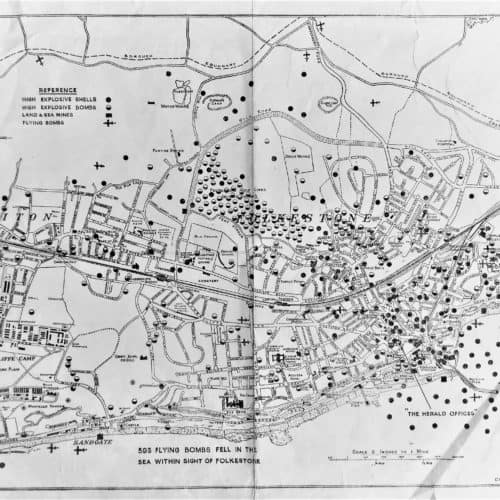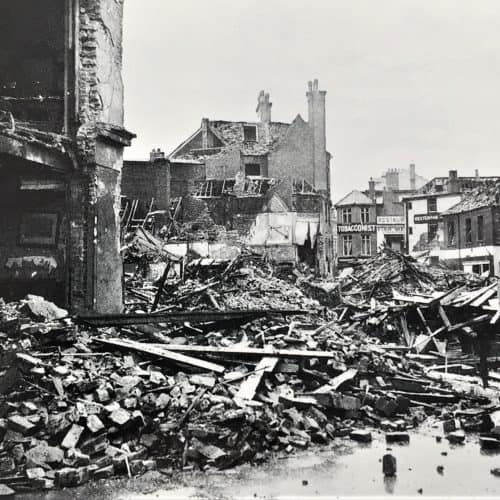WW2 1: bomb map
This map shows where bombs fell in Folkestone during World War 2.
Folkestone was one of the most heavily bombed towns in Britain as it was close to enemy-occupied territory. It was so dangerous, that most people went to live elsewhere, including thousands of evacuee children. At the outbreak of war there were 47,000 people living in Folkestone, but by 1943 only 19,000 remained.
There are different symbols on the map for the different types of bombs.
High explosive bombs were dropped by German bombers during air raids.
High explosive shells were fired over the English Channel by big guns in German-occupied France
Flying bombs (known as doodlebugs) were unmanned rockets launched against Britain in the summer of 1944.
Land mines were attached to parachutes. They detonated at rooftop level to cause maximum devastation.
Sea mines were dropped in the English Channel to blow up British ships.
Zoom in to see which streets the bombs hit.
If you live or go to school in Folkestone, it is likely a bomb fell near to your house or school.
Why not research this? Perhaps see if any evidence survives in the street today. Quite often, where a bomb fell, damaged houses were demolished and new ones built to replace them.
This map was issued by the Folkestone Herald newspaper towards the end of the war to raise money for the RAF Benevolent Fund.
Just before 4am on the night of 18 November 1940, two parachute mines exploded at Beach Street, Folkestone.
The photo shows what was left after the sun came up again. It was the worst incident of the war.
Buildings were flattened like paper. Many people were killed instantly as they slept, and still more buried alive.
In the crowded Beach Street area near the harbour, several pubs, cafes and restaurants were destroyed. A baker’s shop was reduced to rubble.
In the shattered George Hotel, a brass bedstead hung precariously from the side of the building several floors up.
14 people were killed and 60 injured. 56 shops and houses were demolished, or partly demolished, and another 674 properties seriously damaged.
Heroic Rescue Teams moved tons of rubble in a frantic search for survivors. Several people were brought out alive, including the baker and his wife.
Police Constable Spain (who had already been awarded the George Cross, Britain’s highest civilian gallantry award) in a previous air raid, spotted the German bomber, silhouetted in the moonlight, about 800 feet up. He was almost immediately knocked unconscious in the terrific explosion.
He came round shortly afterwards, and rescued a little girl from a pub, before collapsing on his way back to the Police Station.
Despite the widespread loss of life and devastation the ‘Blitz spirit’ shone through. One Rossendale Road housewife was delighted, when digging through the rubble of her flattened house she found her three Christmas puddings. And by noon the next day, two fish-hawkers had retrieved their barrow from under the debris and were selling herrings.
The devastation was so great that much of the Beach Street area was never re-built.
Did you know?
There were 102 air raids on Folkestone in World War 2, which killed 102 people, seriously injured 240 and damaged over 14,000 properties.


